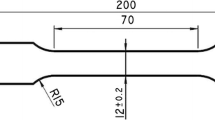Abstract
The cut-edge properties of automotive structures formed during the manufacturing processes significantly influence fatigue and formability performance of high-strength steels. This factor is becoming increasingly important as advanced high-strength transformation-induced plasticity TRiP-aided DP600 steels under examination exhibit an increased sensitivity to fatigue cracks initiating from mechanical cut-edges. It was determined that under prestraining, the effects of plastic deformation of the microstructure can be used to optimize fatigue life. This was particularly the case where the prestraining significantly improved the fatigue lives of mechanical cut-edges up to a prestrain level of 5%. It is proposed that the effect of prestraining can be used to optimize the fatigue lives of even damaged mechanical cut-edges. These parameters can be used in the manufacture of structures with both optimum formability and fatigue lives.











Similar content being viewed by others
Abbreviations
- AHSS:
-
Advanced high-strength steel
- HAZ:
-
Heat-affected zone
- HCF:
-
High cycle fatigue
- LCF:
-
Low cycle fatigue
- TRiP:
-
Transformation-induced plasticity
- A :
-
Elongation to failure
- E–N :
-
Strain–life
- LCF:
-
Low cycle fatigue
- R :
-
Stress ratio (min stress/max stress)
- S–N :
-
Stress–life
References
Kishida, K.: High strength steel sheet for light weight vehicle. NIPPON Steel Tech. Rep. 81, 12–16 (2000)
Thomas, D.J., Whittaker, M.T., Bright, G.W., Gao, Y.: The influence of mechanical and CO2 laser cut-edge characteristics on the fatigue life performance of high strength automotive steels. J. Mater. Process. Technol. 211, 263–274 (2011)
Meurling, F., Melander, A., Linder, J., Larsson, M., Trogen, H.: The influence of laser cutting on the fatigue properties of thin sheet steels. Swedish Institute for Metals Research Report IM-3691 (1998)
Keeler, S.: Cutting sheet metal reduces edge formability. The Science of Forming Magazine Article, March (1999)
Schaeffler, D.J.: Introduction to advanced high strength steels part I: grade overview. http://www.thefabricator.com/MetalsMaterials/MetalsMaterials_Article.cfm?ID=1139 (2005). Accessed 6 Dec 2012
Thomas, D.J.: Effect of mechanical cut-edges on the fatigue and formability performance of advanced high-strength steels. J. Fail. Anal. Prev. 12, 518–531 (2012)
Yan, B.: Fatigue behaviour of advanced high strength steels for automotive applications. In: Great Designs in Steel Seminar. American Iron and Steel Institute, Washington, DC, pp. 1–22 (2003)
Maronne, E., Galtier, A., Labesse-Jied, F., Robert, J.L.: Influence of a cut edge on steel sheets fatigue properties. In: Proceedings of the 5th EIS International Conference Fatigue 2003 on Fatigue & Durability Assessment of Materials, Components and Structures, Cambridge, 7–9 Apr 2003, pp. 323–330 (2003)
Yanm, B., Xu, K.: In: 44th Mechanical Working and Steel Processing Conference Proceedings. Iron and Steel Society, AIME, Warrendale, PA, vol. 40, p. 493 (2002)
Song, S.M., Sugimoto, K.-I., Kandaka, S., Futamura, A., Kobayashi, M., Masuda, S.: Effects of prestraining on high-cycle fatigue strength of high-strength low alloy TRIP-aided steels. Mater. Sci. Res. Int. 9, 223–229 (2003)
Meurling, F., Melander, A., Linder, J., Larsson, M.: The influence of mechanical and laser cutting on the fatigue strengths of carbon and stainless sheet steels. Scand. J. Metall. 30, 309–319 (2001)
Zackay, V.F., Parker, E.R., Fahr, D., Bush, R.: The enhancement of ductility in high strength steels. Trans. ASM 60, 252–259 (1967)
Matsumura, O., Sakuma, Y., Takechi, H.: TRIP and its kinetic aspects in austempered 0.4C–1.5Si–0.8Mn steel. Scr. Metall. 27, 1301–1306 (1987)
Srivastava, A.K., Bhattacharjee, D., Jha, G., Gope, N., Singh, S.B.: Microstructural and mechanical characterization of C–Mn–Al–Si cold-rolled TRIPaided steel. Mater. Sci. Eng. A 446, 549–557 (2007)
Takechi, H., Matsumura, O., Sakuma, Y.: Japan Kokai Tokyo Koho Japan Patent 62, vol. 188, p. 729 (1987)
Sugimoto, K.I., Kanda, A., Kikuchi, R., Hashimoto, S.I., Kashima, T., Ikeda, S.A.: Ductility and formability of newly developed high strength low alloy TRIP-aided sheet steels with annealed martensite matrix. ISIJ Int. 42, 910–915 (2002)
Acknowledgments
The present research was funded by a grant from the Engineering and Physical Sciences Research Council (EPSRC). The author wishes to gratefully acknowledge the support of Swansea University College of Engineering and the Engineering Centre for manufacturing and materials during the pursuit of this research.
Author information
Authors and Affiliations
Corresponding author
Rights and permissions
About this article
Cite this article
Thomas, D.J. Optimizing the Prestrain Fatigue Performance of Transformation-Induced Plasticity-Aided Steel. J Fail. Anal. and Preven. 13, 90–97 (2013). https://doi.org/10.1007/s11668-012-9637-2
Received:
Published:
Issue Date:
DOI: https://doi.org/10.1007/s11668-012-9637-2




